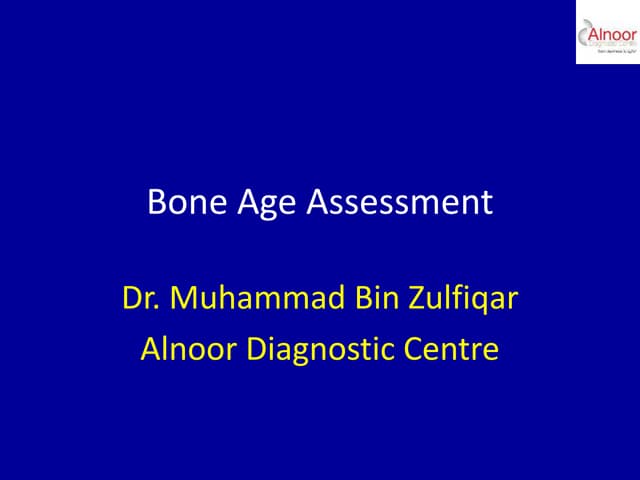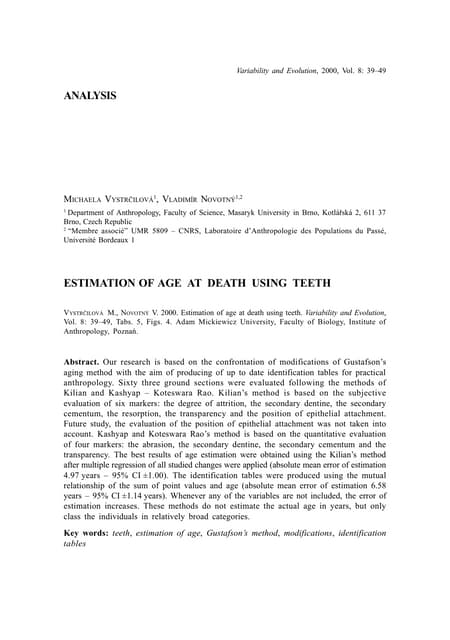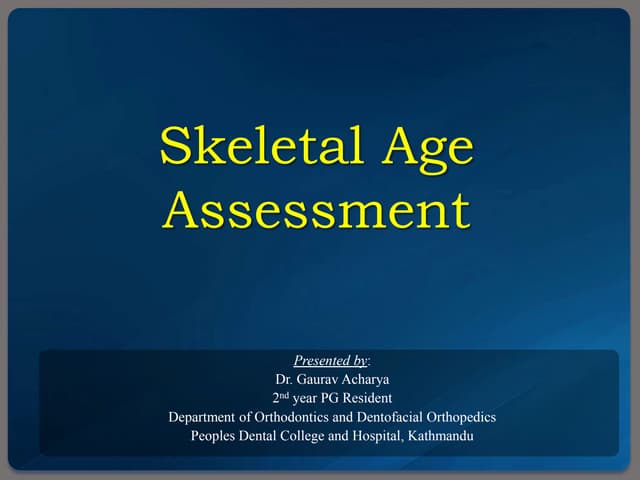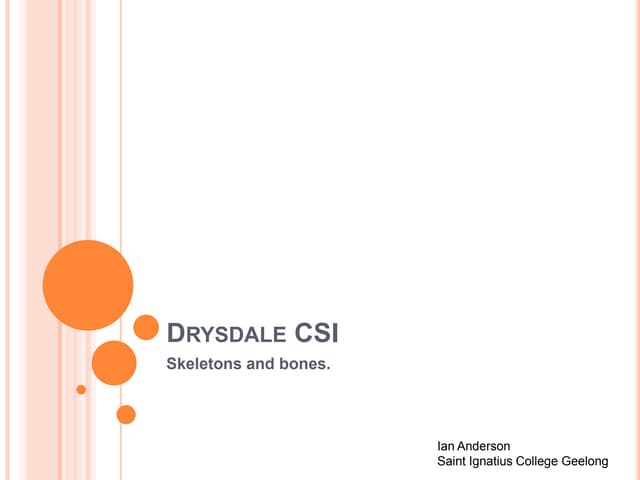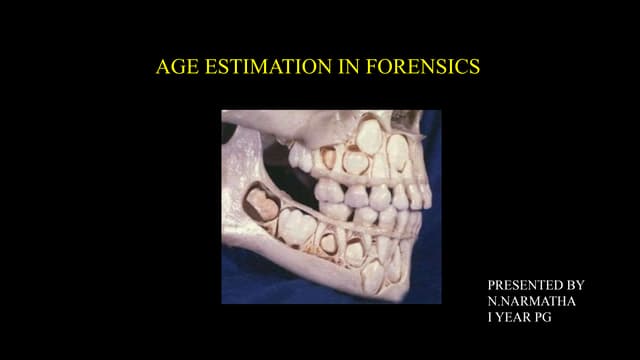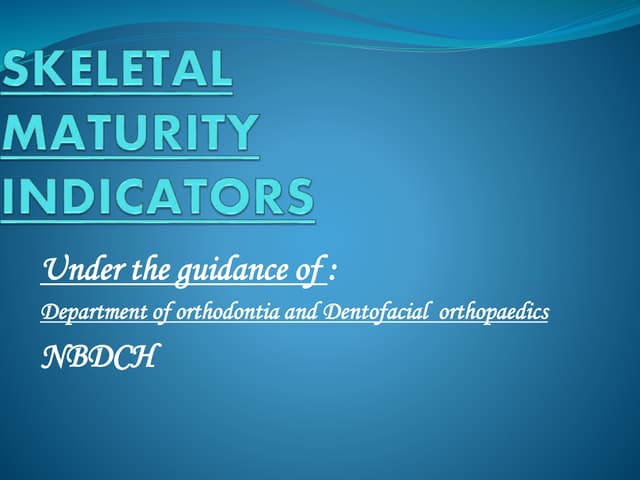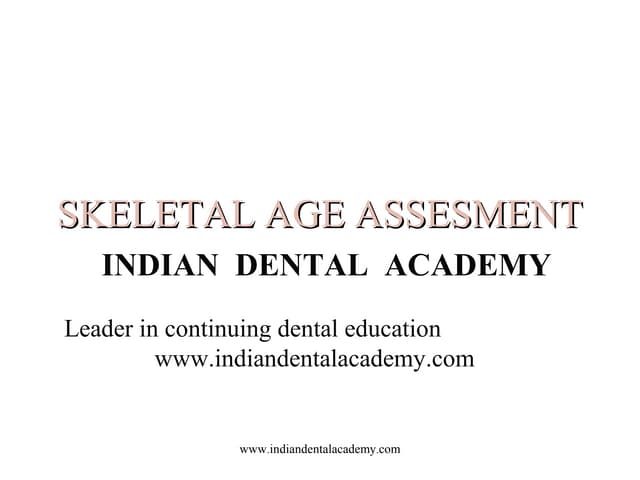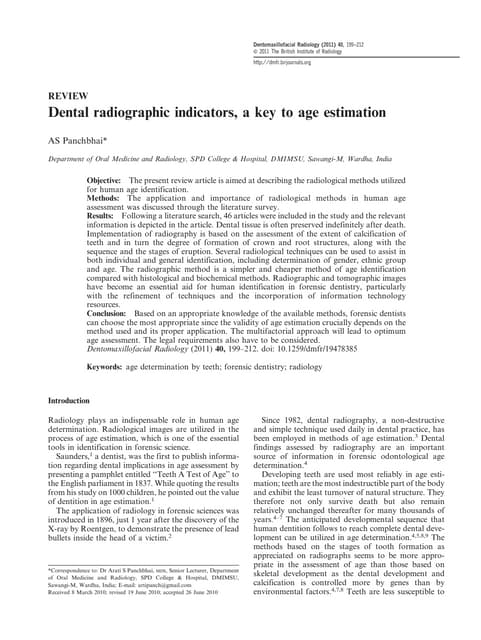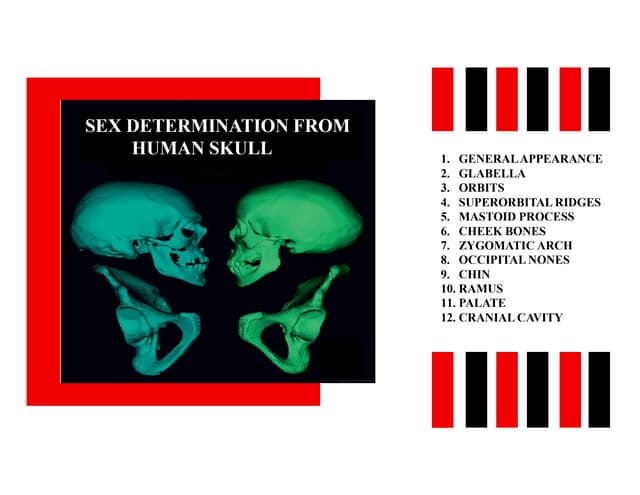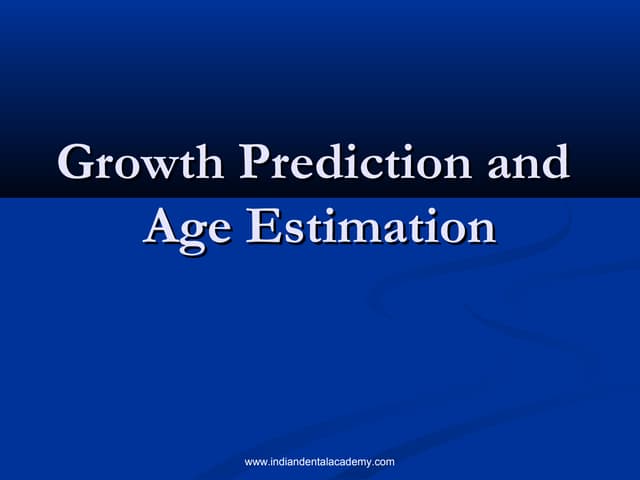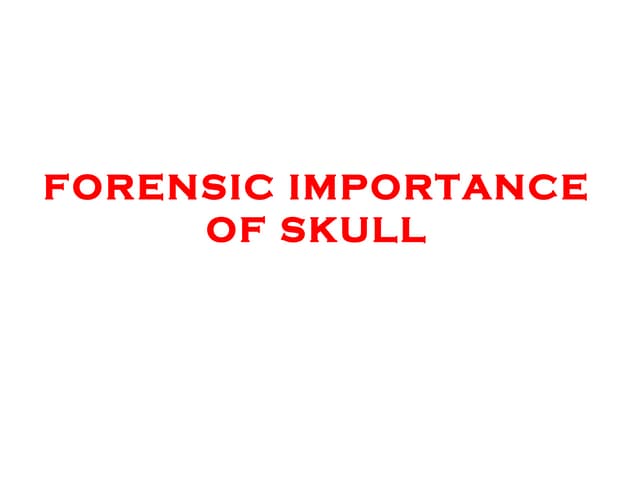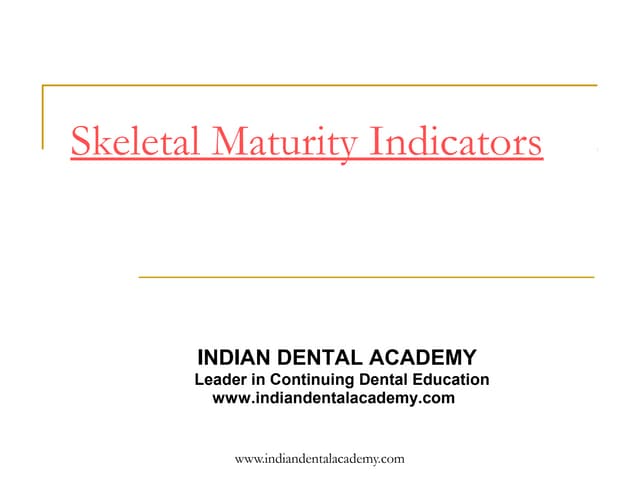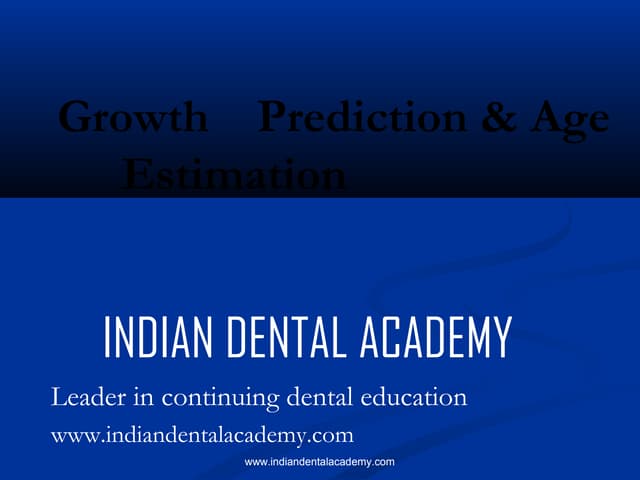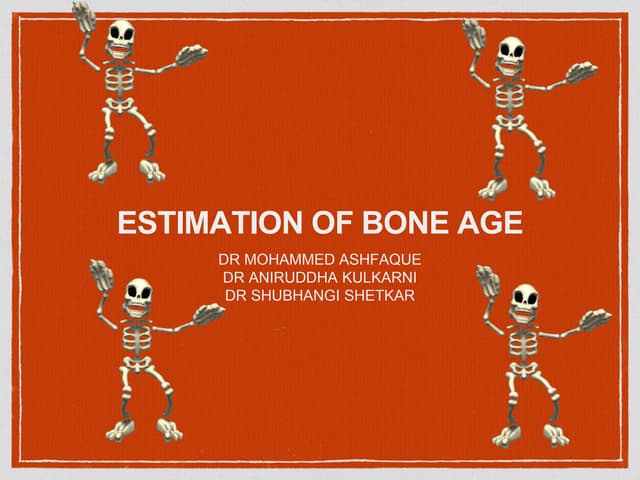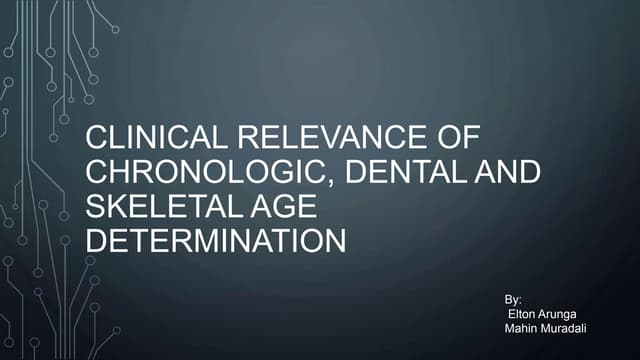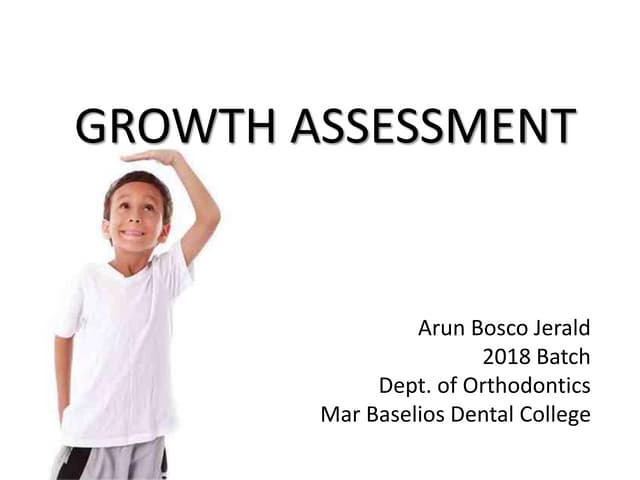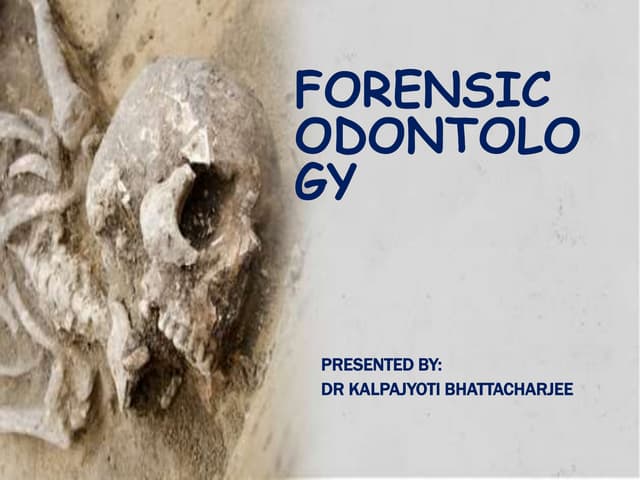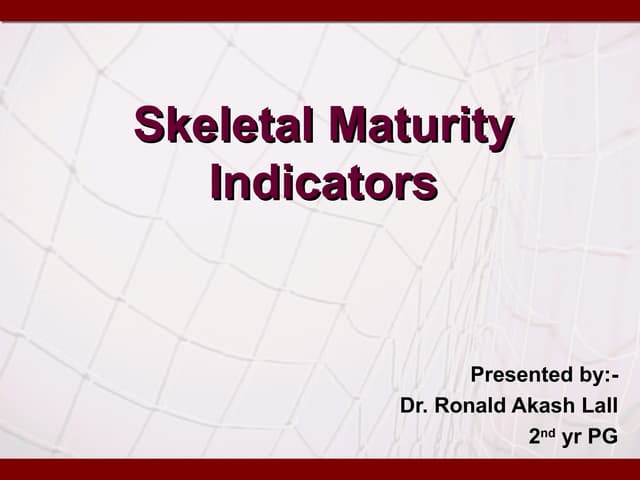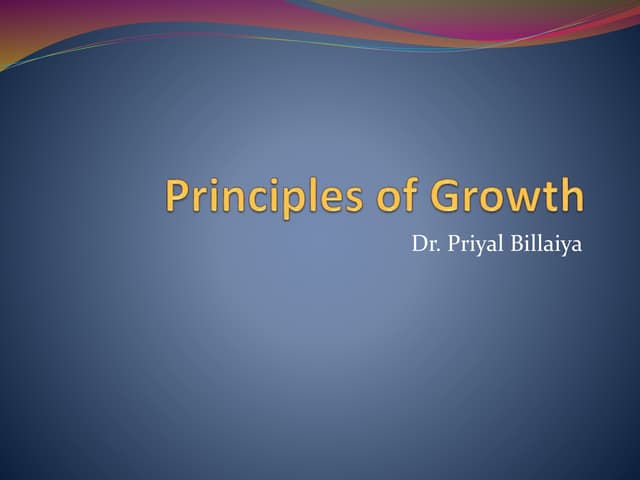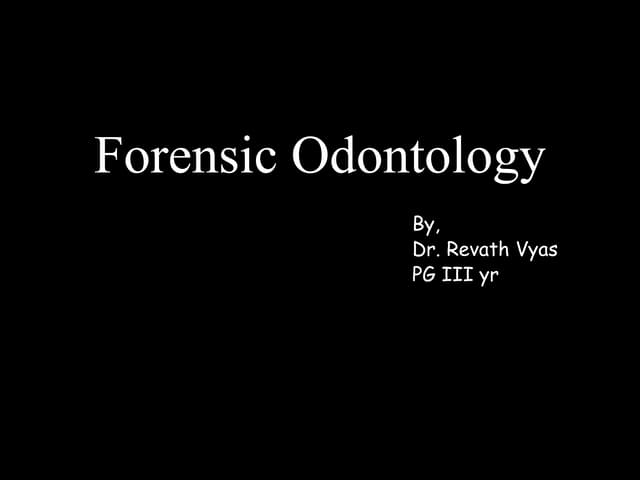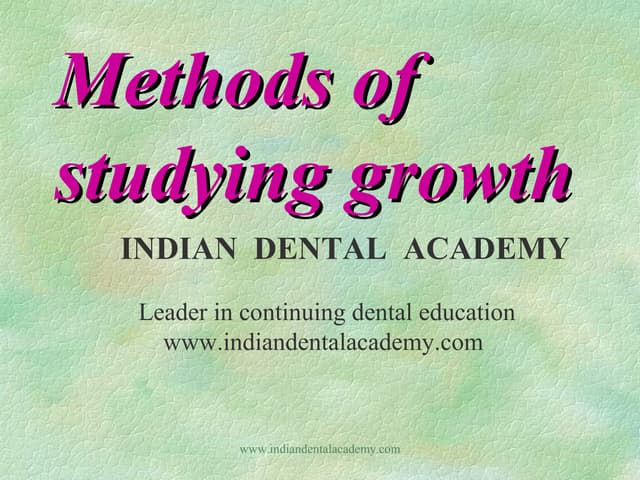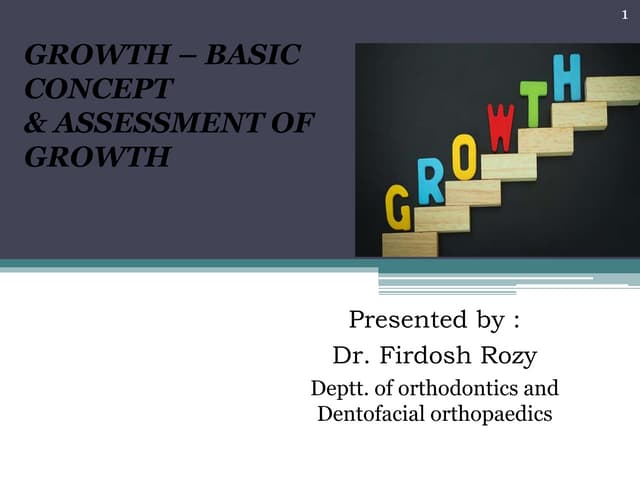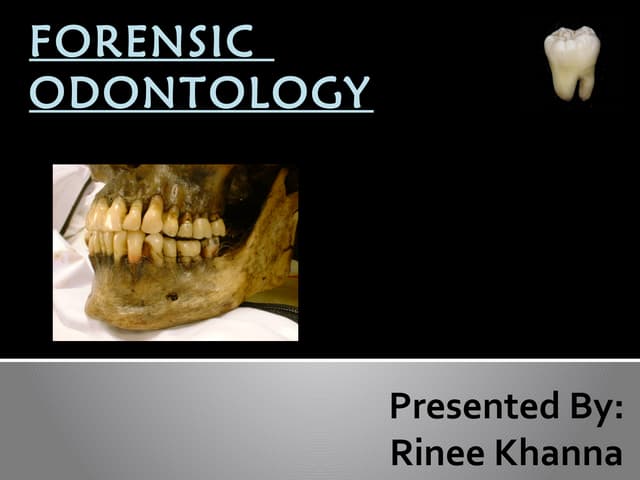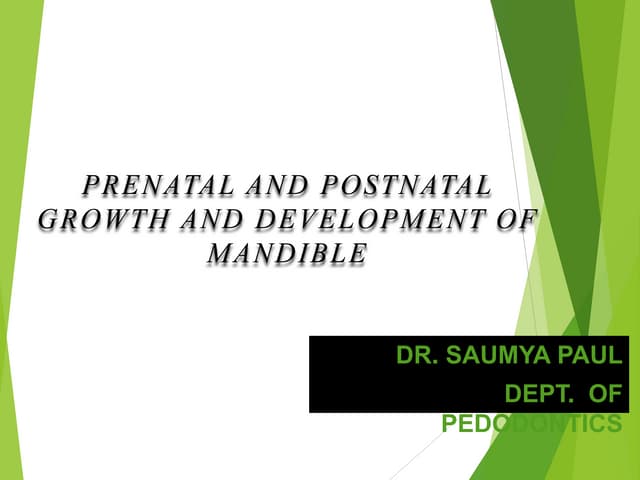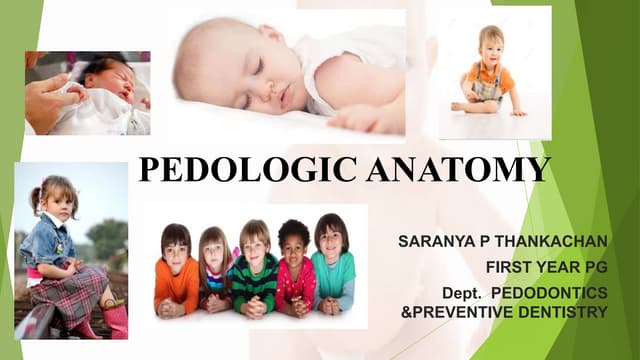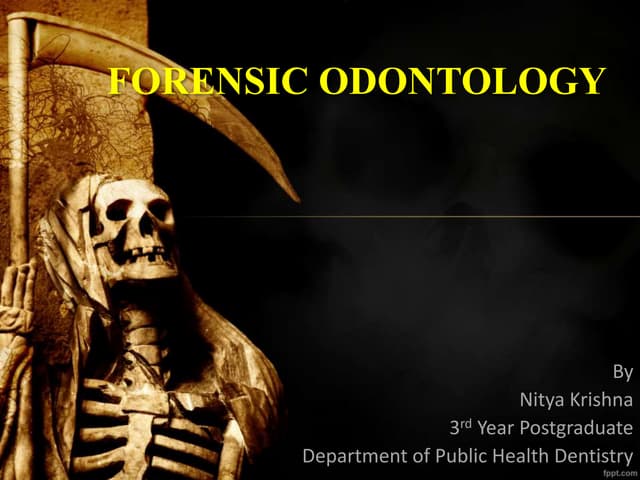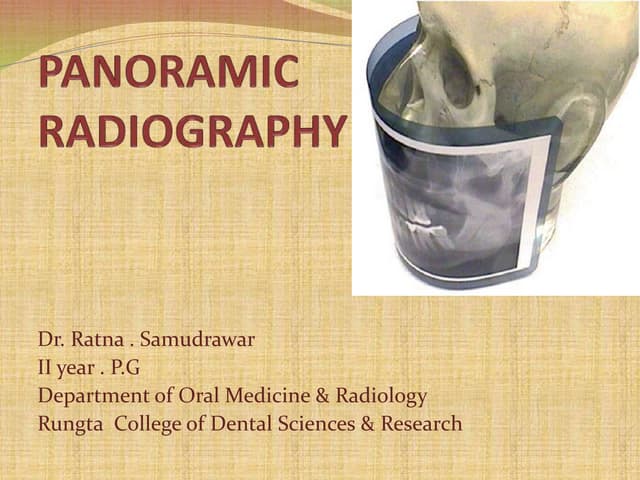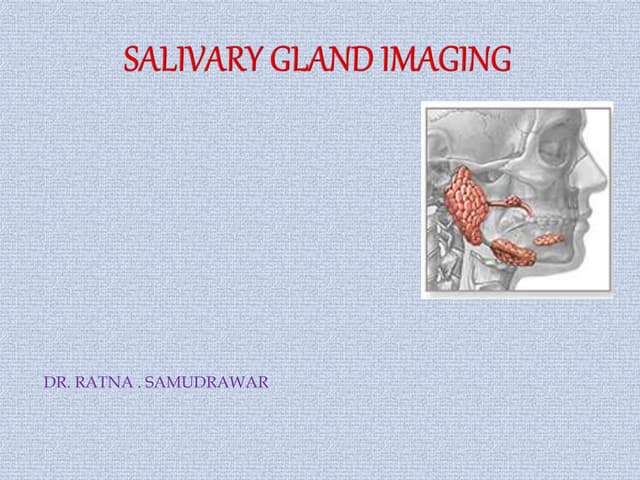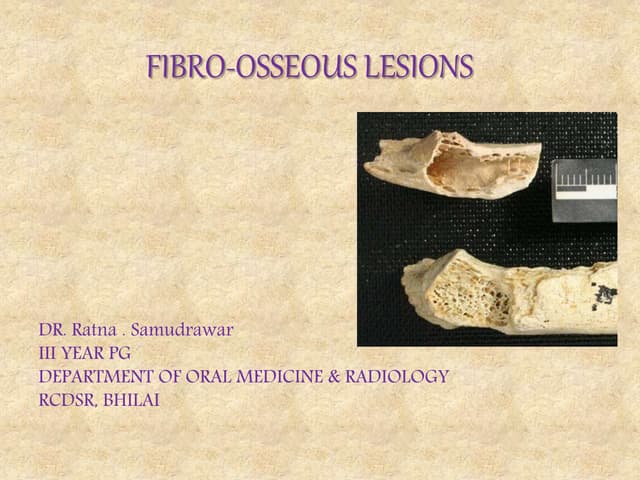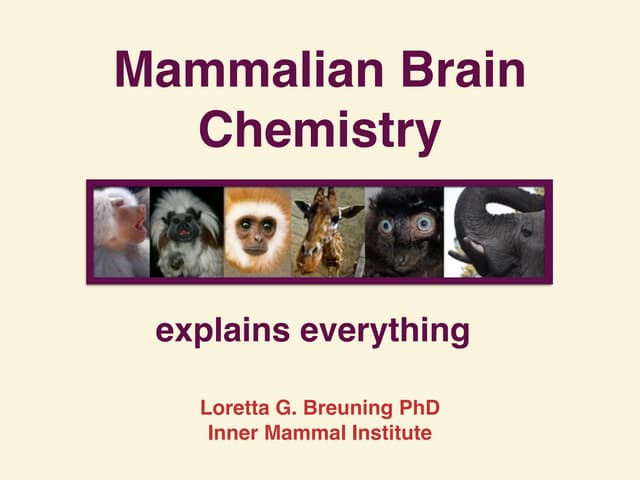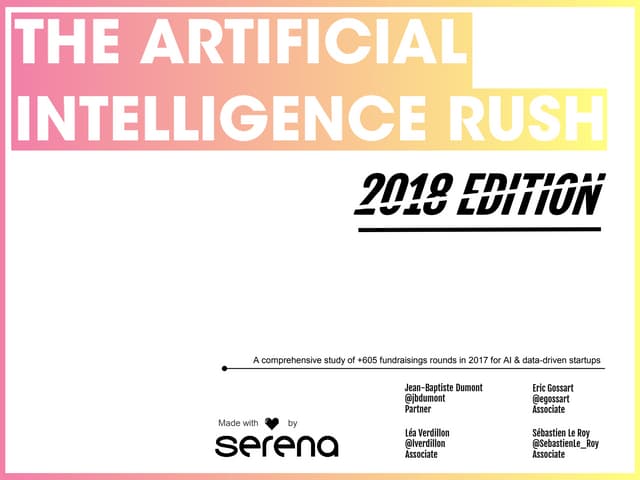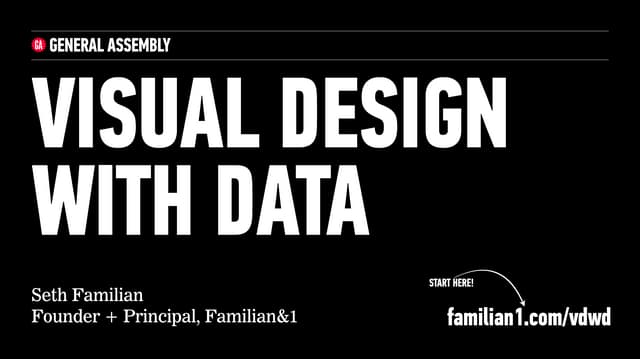Check these out next
Age estimation
- 1. DR. RATNA . SAMUDRAWAR III YEAR PG DEPARTMENT OF ORAL MEDICINE & RADIOLOGY RCDSR, BHILAI
- 2. Contents : Introduction Types of age – chronolgical age height & weight skeletal age Dental age Skeletal age determination Dental age estimation morphologic /visual examination radiographic examination histological examination biochemical examination Age estimation using the dentition in three phase Ageing in prenatal, neonatal & early post natal Age estimation in children & adolscents Age estimation in adults Factors useful in dental age estimation Conclusion References
- 3. Introduction : Age estimation is an important factor in biological identification in many forensic fields, such as forensic odontology, forensic medicine, forensic anthropology, and forensic osteology. Age estimation assists in narrowing the search possibilities for unidentified deceased or living individuals for legal purposes. Additionally, age estimation helps determine the age of perpetrators and their subsequent penalty for criminal liability, particularly in young people
- 4. According to The Criminal Code of the Kingdom of Thailand, the critical ages for criminal liability in young people are 10, 13, 15, 18, and 20 years old. Especially important is the age of 18 years, which indicates adult status. Therefore, accuracy of age estimation methods for suspects with unknown chronological age, who are involved in a serious crime, is needed in the interest of justice.
- 5. In 2000, an international and interdisciplinary study group on forensic age estimation in Berlin, Germany recommended that methods for age estimation in living people should consist of a physical examination, radiographic examination of the hand bones, and dental examination using panoramic radiographs. All of these methods have advantages and disadvantages, for example a drawback of evaluating ossification of the hand bones is that the development of these bones is completed at about 18 years of age, which is earlier than tooth development (third molar teeth) that continues until the early twenties.
- 6. Furthermore, skeletal indicators can present disadvantages due to variations in bone development, which can be influenced by many factors such as nutritional and environmental effects. Tooth development, on the other hand, is controlled more by genetics rather than by environmental and nutritional factors. Additionally, teeth are the strongest structures in the human body and are protected by the soft and hard tissues of the face, this makes dental structures highly resistant to external factors, such as the decomposition process and extreme temperatures (up to 1100 °C). It is these factors that make teeth a superior biological indicator for age estimation.
- 7. TYPES OF AGE: CHRONOLOGICAL AGE OR REAL AGE: It is the measured by the calender, whether it be a period of IU development or number of years after birth HEIGHT AND WEIGHT: Age of a person can be roughly determined from the standard charts of height & weight, but is least accurate & reliable SKELETAL AGE: Determined by the degree of ossification / development of various bones known to occur at particular time in average individual DENTAL AGE: Determined by studying development of various teeth from the time of crypt is visible till the time of root completion
- 8. SKELETAL AGE DETERMINATION Age Changes in Craniofacial Bones Neonatal : Edentulous jaws, orbit size relatively large I year : Fusion of midline symphysis of mandible, Metopic sutures of two halves of frontal bone fuse, Lat. Sphenoidal synchondrose fuse. Fontanelles: Post & ant. Lateral fuse by 3 months. Ant. Fontanelle by 1 ½ yr (18 MONTHS). 3 years : Condylar portion of occipital bone fuses with squamous part of petrous temporal bone. 5 years :Condylar position of occipital bone fuses with basoocciput.
- 9. SPHENOOCCIPITAL SYNCHONDROSIS [between basal part of occipital bone & adj. body of sphenoid] – Major skull cartilage centre, fuses by 18-21 years – most useful skeletal ageing factor.
- 10. Neonatal skull : in this neonatal skull the lack of eruption of the dentition places the age at less than six months after birth. The height of the face is small compared with an older child, whereas the relative size of the orbits is large. In most infants the midline symphysis of the mandible is fused by about one year after birth, and the lack of fusion in this specimen indicates a much lower age. The metopic suture (arrow) between the two halves of the frontal bone fuses at about one year, but there are racial variations.
- 11. The fontanelles : the fontanelles of the skull may be an indication of age in that the anterior fontanelle is said to close by about one and half years of age, the posterior and anterolateral fontanelles by about one year. These dates are somewhat imprecise for particular individuals.
- 12. In this skull the anterolateral fontanelle is still open, indicating that skull is less than three months after birth. (1) The large anterior fontanelle between the frontal and parietal bones closes at about 18 months of age. This structure may be readily seen on radiographs which provide a non invasive method of determining approximate age.
- 13. Skull cartilages: bones developing in cartilage can be used to age a skull. At the base of the skull the lateral sphenoidal synchondroses (1) are said to fuse within the first year of life, but the spheno-occipital synchondrosis(2), lying between the basal part of the occipital bone and adjacent body of the sphenoid, is a major growth centre until later life.
- 14. In skeletonized material the cartilage itself is lost but radiographs will show whether ossification has occurred. Growth at this site producing an anteroposterior lengthening of the skull base is thought to be associated with the downward and forward movement of the upper face. The eruption of the upper second molars occurs at around the age of 12 or 13 years. The spheno occipital synchondrosis begins to fuse shortly after this. It provides one of the most useful skeletal ageing factors at this period of development.
- 15. Skull sutures : once the end of the second decade has been reached there is relatively little change in the skull, but in later life the sutures between the cranial bones are obtained, usually from the inside of the cranium. This process begins in the third and fourth decades of life and the sutures varies markedly from individual to individual. In this case the lambdoid suture, although patent externally (arrow) was in the process of obliteration on its inner aspect, suggesting an age at death of 30 to 55 years.
- 16. SKULL SUTURES From 25 years- Coronal, Sagittlal, lambdoid sutures start closing 32 – 35yrs - Sagittal 40 yrs - Coronal 45yrs - Lambdoid 60yrs - Squamous portion of temporal bone fuses with parietal bone. CRANIAL SUTURES Open - < 30 yrs Closing - 30-55 yrs Closed - > 55yrs. MANDIBULAR ANGLE Infancy- 160 – 1750 1 – 3years - 150 - 1600 6 – 12years - 125 - 1400 15-17years - 120 - 1300 18-21years - 900-1250 30-40years - 950-1150 > 40 year - obtuse angle
- 17. Evaluation of Cervical Vertebrae Maturity Index on Lateral Cephalogram CVMI were evaluated by classifying C2, C3, and C4 into six groups depending on their maturation patterns on the lateral cephalogram using the classification of Hassel and Farman.
- 18. Hand wrist method: The most commonly used method is based on a single x-ray of the left hand, fingers, and wrist . The bones in the x-ray are compared to the bones of a standard atlas, usually "Greulich and Pyle”. sometimes called as atlas, or inspectional, method. A more complex method also based on hand x-rays is the "TW2"or the "TW3"method (TW = Tanner Whitehouse) method.
- 19. The atlas contains reference images of male and female standards of the left wrist and hand from birth till 18 years for females and 19 years for males. The method entails the matching of a hand – wrist X-ray of a specific child as closely as possible with a series of standard X-ray plates, which correspond to successive levels of skeletal maturity at specific chronological ages. Eg : if the hand wrist X-ray of a 7 year old child matches the standard plate of 8-year-old children, the child’s SA is 8 years. This method is simpler and faster than other radiograph based methods.
- 20. OSSIFICATION CENTRES From 2nd month IU to 2nd year of extra uterine life From 3rd yr to mid teens – Secondary Ossification centres appear Next decade- Primary Ossification centre (Diaphyses) unite with secondary ossification centres (epiphyses) Primary Ossification centres appear in the skeleton
- 21. MANDIBULAR CHARACTERISTICS USEFUL IN AGEING Infancy Adult Oldage Body Shallow Thick & long Shallow Ramus Forms an obtuse angle with the body Forms an approximate right angle Obtuse angle Mental foramen Located near the lower margin of the body Midway between upper & lower margin Near alveolar margin Condyle Occupies a level lower to the coronoid process Elongated and projects above the coronoid Neck is bent backwards
- 22. DENTAL AGE ESTIMATION Important Subspeciality of forensic sciences, also has application in living individuals. Literature describes several techniques that address age estimation in adults. Edwin Saunders, a dentist, was the first to publish information regarding dental implications in age assessment by presenting a pamphlet entitled “Teeth A Test of Age” to the English parliament in 1837. Dental Age Estimation Methods a. Morphologic / visual Examination b. Radiographic Examination c. Histological Examination and d. Biochemical Examination
- 23. MORPHOLOGICAL METHODS: Morphological methods are based on assessment of teeth (ex- vivo). Hence, these methods require extracted teeth for microscopic preparation. However, these methods may not be acceptable due to ethical, religious, cultural, or scientific reasons. Gustafson (1950), Dalitz (1962), Bang and Ramm (1970), Johanson (1971), Maples (1978), Solheim (1993) are few morphological methods. Disadvantage: Cannot be used in living person.
- 24. BIOCHEMICAL METHODS The biochemical methods are based on the racemization of amino acids. The racemization of amino acids is a reversible first-order reaction and is relatively rapid in living tissues in which metabolism are slow. Aspartic acid has been reported to have the highest racemization rate of all amino acids and to be stored during aging. In particular, L-aspartic acids are converted to D-aspartic acids and thus the levels of D-aspartic acid in human enamel, dentine, and cementum increase with age. Some of the methods are: 1. Helfman and Bada method (1975, 1976)4 2. Ritz et al. method (1995)4
- 25. Helfman and Bada Method (1975, 1976) The authors reported studies that focused on the racemization of amino acids and obtained a significant correlation between age and ratio of D-/l-enantiomers in aspartic acid in enamel and coronal dentin. Ritz et al. Method (1995) Used the racemization method in dentinal biopsy specimens in order to estimate the age of living individuals. This method emerged from the need to identify the age of living individuals without extracting teeth.
- 26. RADIOGRAPHIC METHODS Radiology plays an indispensable role in the human age determination. Radiological images are utilized in the process of age estimation, which is one of the essential tools in identification in forensic science. Radiographic assessment of age is a simple, non-invasive and reproducible method that can be employed both on living and unknown dead. Various radiographic images that can be used in age identification are intraoral periapical radiographs, lateral oblique radiographs, cephalometric radiographs, panoramic radiographs, digital imaging and advanced imaging technologies.
- 27. The radiological age determination is based on assessment of various features as follows: • Jaw bones prenatally • Appearance of tooth germs • Earliest detectable trace of mineralization or beginning of mineralization • Early mineralization in various deciduous teeth during intrauterine life • Degree of crown completion • Eruption of the crown into the oral cavity • Degree of root completion of erupted or unerupted teeth. • Degree of resorption of deciduous teeth • Measurement of open apices in teeth • Volume of pulp chamber and root canals/formation of physiological secondary dentine • Tooth-to-pulp ratio • Third molar development and topography
- 28. Age estimation using the dentition may be grouped into three phases a. Ageing in prenatal, neonatal & early Post natal b. Age estimation in children and adolescents c. Age estimation in adults
- 29. FACTORS USEFUL IN DENTAL AGE ESTIMATION: 1. Appearance of tooth germs 2. Earliest detectable trace of mineralization 3. Degree of Completion of unerupted teeth 4. Rate of formation of enamel and formation of the neonatal line 5. Clinical eruption 6. Degree of completion of the roots of erupted teeth 7. Degree of resorption of the roots of deciduous teeth 8. Attrition of the crown
- 30. 9 . Formation of physiologic secondary dentine 10. Formation of cementum 11. Transparency of root dentine 12. Gingival recession 13. Root surface resorption 14. Discoloration and staining of the teeth 15. Influence of disease or malnutrition on tooth eruption 16. Influence of Sex on tooth eruption 17. Changes in the chemical composition of the teeth Dental & skeletal ages correspond closely in the male, in the female, the skeletal age is one year ahead of dental age.
- 31. Miscellaneous Some odontologists advocate, the use of aspartic acid racemization, claiming an accuracy of ±4 years. Additional methods include the use of SEM-EDXA, a method used to examine dentine in relation to age determination. A recent study from the UK examined the use of root length, in the determination of age in paediatric cases
- 32. AGE ESTIMATION IN PRENATAL, NEONATAL AND EARLY POST NATAL CHILD 1. Primary tooth germ begins to form at seven weeks in utero(IU) & enamel formation of all deciduous teeth complete by first year. 2. Permanent tooth germ begins to form at 3.5 to 4 months IU 3. Prenatal age estimation uses histological techniques, enables observation of tooth mineralization upto 12 weeks before it is apparent on radiographs.
- 33. 4. Neonatal line – indicator of birth, - slowing down of enamel prism growth rate, thus creating an apparent line of demarcation. 5. Amount of enamel & dentin before & after birth taken as basis & enamel & dentin formed after birth divided by daily rate of formation 16mm/day indicates approximate age.
- 34. Radiographically, the mineralization of deciduous incisors starts at the 16th week of intrauterine life. Before the mineralization of tooth germs starts, the tooth germs may be visible as radiolucent areas on the radiograph; the subsequent radiographs of the mandible will depict the deciduous teeth in various stages of mineralization as per the pre-natal age of the fetus. One of the methods employed is: Stages by Kraus and Jordan (1965)- They studied the early mineralization in various deciduous teeth as well as the permanent first molar. The development is described in 10 stages, denoted by Roman numerals from I to X; the IXth stage includes three stages and the Xth stage includes five stages.
- 35. B. AGE ESTIMATION IN CHILDREN AND ADOLESCENTS 1. Tooth emergence or Eruption 2. Tooth calcification 1. ERUPTION:- Convenient clinical method visual assessment of teeth & compared with radiographs & charts. Main drawback is emergence patterns are under the influence of intraoral environment [infection, arch space, premature tooth loss]
- 36. 2. CALCIFICATION:- better alternative, since, Calcification can be observed for a period of several years from radiographs not altered by local factors assess age at periods when no emergence takes place [2.5 – 6yrs & more than 12yrs]
- 37. Methods for estimating age in Children and adolescents SCHOUR AND MASSLER’S METHOD:- 1. In 1941, Schour and Masseler studied the development of deciduous and permanent teeth, describing 21 chronological steps from 4 months to 21 years of age and published the numerical development charts for them. 2. These charts do not have separate surveys for males and females. Ubelaker’s improved charts should be used since the original schour & Massler chart had serious drawbacks
- 38. Nolla’s method (1960) Nolla evaluated the mineralization of permanent dentition in 10 stages. After every tooth is assigned a reading, a total is made of the maxillary and mandibular teeth and then the total is compared with the table given by Nolla. The advantages of this method are that it can be applied to an individual with or without the third molar and that girls and boys are dealt with separately.
- 39. Age estimation using open apices (Cameriere method) Various studies assessed the relationship between the age and measurement of open apices in teeth. The seven left permanent mandibular teeth were valued. The number of teeth with root development completed with apical ends completely closed was calculated (N0). For the teeth with incomplete root development, that is, with open apices, the distance between inner sides of the open apex was measured (A).
- 40. For the teeth with two roots, the sum of the distances between inner sides of two open apices was evaluated. To nullify the magnification, the measurement of open apex or apices (if multirooted) was divided by the tooth length (L) for each tooth and these normalized measurements of seven teeth were used for age estimation.
- 41. The dental maturity was calculated as the sum of normalized open apices (s) and the numbers of teeth with root development complete (N0). The values are substituted in the following regression formula for age estimation. Age = 8.971 + 0.375 g + 1.631 × 5 + 0.674 N0 – 1.034 s – 0.176 s N0 Where g is a variable equal to 1 for boys and 0 for girls.
- 42. Age Estimation in Adults Clinically, the development of permanent dentition completes with the eruption of the third molar at the age of 17-21 years, after which the radiographic age estimation becomes difficult. The two methods commonly followed are the assessment of the volume of teeth and the development of the third molar. 1. Volume assessment of teeth a. Pulp-to-tooth ratio method by Kvaal b. Coronal pulp cavity index 2. Development of third molar a. Harris and Nortje method b. Van Heerden system
- 43. . THIRD MOLARS IN AGE ESTIMATION:- All four third molars are calcified, the chances of the individual being 18yrs old is 96.3% in males & 95.1% in females. Van Harden developed five stage system measuring mesial root of developing mand 3rd molar. Stage 1:- Crown complete, 16.8 – 16.9yrs Radiographic evidence of root formation Stage 2:- Root length >1/3 <1/2 17.5 years Stage 3:- Root length >2/3 17.8 – 17.9 yrs but not complete Stage 4:- Root fully formed18.4 – 18.5yrs with open apex Stage 5:- Apex closed18.9 – 19.2yrs
- 44. RADIOGRAPHIC METHOD OF KVAAL AND ASSOCIATES Developed a method that used Pulp size measurement of Six teeth (Max CI & LI, 2nd PM, Mand CI, LI, canine & 1st PM) on periapical radiographs. Pulp - Root length (P) Pulp - tooth length (R) Tooth - Root length(T) Pulp - root width at CEJ (A) Pulp - root width at mid root level (C) Pulp - root width at midpoint between level C & A (B), Mean value of width ratios B and C (W) Mean value of length ratios P and R (L) Mean values of all ratios excluding T (M) Regression formula, Age = 129.8 – 316.4 (M) – 66.8 (W-L)
- 45. DEMIRJIAN’S METHOD:- In 1973, Demirjian introduced a method (DemI973) which estimated chronological age based on developments of seven teeth from the left side of the mandible. This method was similar to that of Tanner, Whitehouse, and Healy, who estimated chronological age based on the maturity of hands and wrists. Demirjian, Goldstein, and Tanner used the stages have usually been marked by recognizable tooth shapes, from the beginning of calcification through to final mature form. Useful stages must be easily recognizable, and such that a tooth always passes through the same stages in every individual
- 46. Since the stages are indicators of maturity and not of the size, they cannot be defined by any absolute length measurements. In it the final scores for each tooth, previously constrained each to be 100, are allowed to vary so that only their sum (or average) over all the teeth is 100. This makes allowance for the different ages at which different teeth maturity scores for girls and boys are given.
- 47. Assigning the ratings: 1. The mandibular permanent teeth are rated in the following order: 2nd molar, 1st molar, 2nd bicuspid, 1st bicuspid, canine, lateral incisor, central incisor. 2. All teeth are rated on a scale A-H. The rating is assigned by following carefully the written criteria for each stage and by comparing the tooth with the diagrams and X-ray pictures given for comparison. For each stage, there are one, two or three written criteria marked a, b, c.
- 48. If only one criterion is given, this must be met for the stage to be taken as reached; if two criteria are given, then it is sufficient if the first one of them is met for the stage to be recorded as reached; if three criteria are given, the first two of them must be met for the stage to be considered reached. At each stage, in addition to the criteria for that stage, the criteria for the previous stage must be satisfied. In borderline cases, the earlier stage is always assigned.
- 49. 3. There are no absolute measurements to be taken. A pair of dividers is sufficient to compare the relative length (crown/root). To determine apex closure stages, no magnifying glass is necessary. The ratings should be made with the naked eye. 4. The crown height is defined as being the maximum distance between the highest tip of the cusps and the cementoenamel junction. When the buccal and lingual cusps are not at the same level, the midpoint between them is considered as the highest point.
- 50. Dental Formation Stages If there is no sign of calcification, the rating 0 is given: The crypt formation is not taken into consideration. Stage Description In both uniradicular and multiradicular teeth, a beginning of calcification is seen at the superior level of the crypt in the form of an inverted cone or cones. There is no fusion of these calcified points. Fusion of the calcified points forms one or several cusps which unite to give a regularly outlined occlusal surface.
- 51. C. a. Enamel formation is complete at the occlusal surface. Its and convergence toward the cervical region is seen. b. The beginning of a dentinal deposit is seen. c. The outline of the pulp chamber has the outline of the pulp chamber has a curved shape at the occlusal border.
- 52. D. a. The crown formation is completed down to the cementoenamel junction. b. The superior border of the pulp chamber in the uniradicular teeth has a definite curved form, being concave toward the cervical region. The projection of the pulp curved shape at the occlusal border horns if present, gives an outline shaped like an Umbrella top in molars the pulp chamber has a trapezoidal form. c. Beginning of root formation is seen in the form of a spicule.
- 53. E. Uniradicular teeth a. The walls of the pulp chamber now form straight lines, whose continuity is broken by the presence of the pulp horn, which is larger than in previous stage the crown height. b. The root length is less than the crown height. • Molars: a. Initial formation of the radicular bifurcation is seen in the form of either a calcified point or a semi-lunar shape. b. The root length is still less than crown height.
- 54. F. Uniradicular teeth a. The walls of the pulp chamber now form a more or less isosceles triangle. The apex ends in a funnel shape. b. The root length is equal to or greater than the crown height. • Molars: a. The Calcified region of the bifurcation has developed further down from its semi-lunar stage to give the roots a more definite and distinct outline with funnel shaped endings. b. The root length is equal to or greater than the crown.
- 55. G. The walls of the root canal are now parallel and, its apical end is still partially open. H. The apical end of the root canal is completely closed. a. The periodontal membrane has a uniform width around the root and the apex.
- 56. Using the Scoring System 1. Each tooth will have a rating (A-H), assessed by the procedure described. 2. This is converted into a score using the table for boys or girls as appropriate. 3. The scores for all seven teeth are added together to give the maturity score. 4. The maturity score may be plotted on the centile charts (boys or girls as appropriate) where the age of the child is known. 5. The maturity score may be converted directly into a dental age either by reading off on the horizontal scale the age at which the 50th centile attains the maturity score value, or by using table which has been constructed by this means.
- 57. Advantages Demirjian and Goldstein’s method is simple, as it is an orthopantomogram based method and it enables more reliable standardization and has good reproducibility and intra- examiner/inter-examiner reliability. One of the reasons for the widespread acceptance of this method is that the maturity scoring system that it creates is universal in application, although the conversion to dental age depends on the population being considered. Furthermore, this conversion can be made with the use of relatively small local samples and can reach an equivalent dental age by comparison for different populations.
- 58. Limitations 1. Demirjian method use orthopantomograms which are difficult to obtain in young children, due to both technical reasons, as well as legal and ethical considerations. 2. Since simultaneous evaluation of seven left mandibular teeth are required, cannot apply it in children with lacking teeth inborn or acquired. 3. This method may not express, agenesis of teeth, distinctive retardation of dental development (excluding third molars), and systemic diseases and various developmental stages of the tooth. 4. The appreciation of developmental stage may become difficult as the choice of the tooth developmental stage is quite subjective. 5. This method does not give maturity scores for stages 1-4 in case of 1st molar, central and lateral incisor; thus excluding the individuals below the age of 4-4.5 years
- 59. Nutshell – demirjian’s system - made up of scoring system - development of seven mandibular teeth was divided into eight stages each [A to H]. - each tooth is assigned a maturity score that corresponds to its developmental stage. - maturity score for each tooth is added and a total maturity score obtained - Total maturity score is plotted on a chronologic ‘age conversion table’ [Separate for both sexes]
- 60. Stage Characteristics Stage A Calcification of single occlusal points without fusion of different calcifications. Stage B Fusion of mineralization points; the contour of the occlusal surface is recognizable. Stage C Enamel formation has been completed at the occlusal surface, and dentin formation has commenced. The pulp chamber is curved, and no pulp horns are visible. Stage D Crown formation has been completed to the level of the cementoenamel junction. Root formation has commenced. The pulp horns are beginning to differentiate, but the walls of the pulp chamber remain curved. Stage E The root length remains shorter than the crown height. The walls of the pulp chamber are straight, and the pulp horns have become more differentiated than in the previous stage. In molars, the radicular bifurcation has commenced to calcify. Stage F The walls of the pulp chamber now form a triangle, and the root length is equal to or greater than the crown height. In molars, the bifurcation has developed sufficiently to give the roots a distinct form. Stage G The walls of the root canal are now parallel, but the apical end is partially open. In molars, only the distal root is rated. Stage H The root apex is completely closed (distal root in molars). The periodontal membrane surrounding the root and apex is uniform in width throughout.
- 61. Considering differences in tooth development between males and females, Chaillet and Demirjian provided separate maturity scores for each sex (Tables 21.4 and 21.5). The score assigned for each of the eight teeth is added and a total maturity score (S) obtained. The total is substituted in regression formulae to derive age. The following formulae may be used when estimating age in Indians: Males: Age = 27.4351 − (0.0097 × S2) + (0.000089 × S3) Females: Age = 23.7288 − (0.0088 × S2) + (0.000085 × S3)
- 62. Other Modifications of Demirjian’s Method In 1976, Demirjian developed three more methods. First (DemI976) was based on the same seven teeth; second (DemI976PM,) on four teeth, specifically the first premolar (PMI l, second premolar (PM2), first molar (M1), and second molar (M2); and the third (Dem1976IN2) on four teeth, specifically the second incisive (12), first premolar (PM1), second premolar (PM2), and second molar (M2)
- 63. GUSTAFSON’S METHOD OF AGE ESTIMATION In 1950, Gosta Gustafson developed age estimation method based on morphological and histological changes of the teeth. 1. Amount of occlusal Attrition (A) 2. Loss of periodontal attachment (P) 3. Coronal secondary dentine deposition (S) 4. Root resorption at the apex (R) 5. Dentine translucency (T) 6. Cementum apposition at the root apex (C) For each regressive changes, 0-3 scores were assigned 0 - unchanged (from development completion stage) 1 - Minimal Change 2 - Moderate change 3 - Severe changes
- 64. The points awarded to each feature are added (e.g. A3 + S2 + P2 + C1 + R2 + T1 =X) ↑ in total score (X) → ↑ in age Age was estimated using the formula Age = 11.43 + 4.56 X with an average error of 3.6yrs. Maples and Rice Corrected the above formula as Age = 13.45 + 4.26 X According to Johanson Instead of four grades (0-3), he proposed seven grades (0, 0.5, 1, 1.5, 2, 2.5 & 3). Using these grades Age = 11.02 + (5.14A) + (2.3S) +(4.14P) + (3.71C) + (5.57R) + (8.98T) was suggested
- 65. DENTINE TRANSLUCENCY Bang & Ramm – first to use dentine translucency for age estimation. Root dentine starts translucent during 3rd decade of life, begins at the apex & advances coronally. Solheim suggested translucency length (in mm) or area (mm2) measured on intact or sectioned teeth. Two equations were given Age = B0 + B1 + B2 X2 for zones of translucency ≤ 9mm Age = B0 + B1 X for zones of translucency >9mm Where B0 is regression constant, B1 & B2 are regression coefficients, X is the translucency length. Disadvantages:- 1. Irregular junction of translucent & non translucent zones. 2. Under estimation of age in old age groups due to slowing down of dentinal sclerosis, restricting further ↑ in translucency
- 66. AGE ESTIMATION FROM INCREMENTAL LINE OF CEMENTUM Kagerer & Grupe suggested age estimation from acellular cementum incremental lines. Mineralized unstained cross-sections of teeth [preferably mand. CI & 3rd molars] are used. Disadvantage:- Necessity to extract and / or section the teeth possible in the dead but not in living individuals.
- 67. OTHER METHODS Age estimation from changes in tooth color Martin–de las Heras & co workers proposed the use of spectro radio metry for dentine color Measurements. Dentinal colors white, cream & yellow – 12 – 37yrs Dentinal colors dark yellow & brown – 55 – 64yrs. Kvaal & Solheim suggested the use of dentine & cementum fluorescence for age estimation ↑ deepening of tooth color - ↑ fluorescence intensity - ↑ in age.
- 68. CONCLUSION In terms of legal representation, age estimation is one of the most important steps for identification in forensic odontology when predicting the age of a deceased or living person. Determination of dental age is done by reference to the ever- growing human deciduous and permanent dentitions. The importance of age estimation includes an assessment of minor/major status in individuals without legal documents, Demirjian method, the widely used method with appropriate modifications shall be a reliable method. .
- 69. Reference : A colour atlas of forensic dentistry – Whittaker and MacDonald Text book of forensic Odontology – KMK Masthan Shafer’s textbook of oral pathology - 6th edn Text book of forensic Odontology – Pramod K Dayal. Age estimation in forensic odontologyodontology maninder kaur ,world journal of pharmaceutical And medical research2016,2(5), 260-265. Age Estimation Methods In Forensic Odontology Phuwadon Duangto Journal of Dentistry Indonesia 2016;23(3):74-80 . Age estimation: a dental approach shamim t, jpafmat, 2006; 6. Issn 0972-5687










